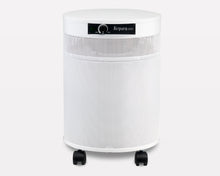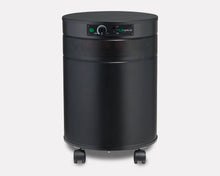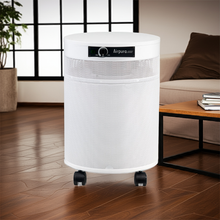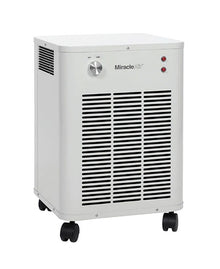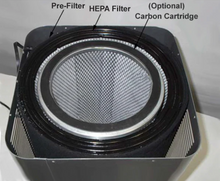Creating a Haven of Clean Air: Whole-Home Air Purification for Multiple Chemical Sensitivity (MCS)
Imagine stepping into your home and instantly feeling a wave of relief, knowing that every breath you take is pure and free from the invisible triggers that can wreak havoc on your health. For individuals living with Multiple Chemical Sensitivity (MCS), this isn't just a desire—it's a necessity.

Imagine stepping into your home and instantly feeling a wave of relief, knowing that every breath you take is pure and free from the invisible triggers that can wreak havoc on your health. For individuals living with Multiple Chemical Sensitivity (MCS), this isn't just a desire—it's a necessity. The constant battle against airborne irritants can make even the safest spaces feel like a minefield. If you find yourself meticulously avoiding everyday products and still experiencing debilitating symptoms within your own four walls, you're likely grappling with the challenge of achieving consistent clean air throughout your entire home. This comprehensive guide delves into the critical importance of whole-home air purification for MCS, offering expert insights and practical solutions to help you create a truly safe and healthy living environment. We'll explore the science behind MCS, the limitations of single-room air purifiers, and how a strategic approach to whole-house air filtration can be a game-changer in managing your sensitivity and improving your quality of life.
Multiple Chemical Sensitivity, often abbreviated as MCS, is a chronic condition characterized by heightened sensitivity to a wide range of common chemicals and environmental triggers. These can include volatile organic compounds (VOCs) found in cleaning products, perfumes, building materials, pesticides, and even seemingly innocuous items like scented candles. For individuals with MCS, exposure to these substances, even at very low levels tolerated by most people, can trigger a cascade of adverse health reactions. Symptoms can vary widely but often include headaches, fatigue, respiratory issues, skin rashes, cognitive dysfunction, and gastrointestinal problems (Ashford & Miller, 1998). The unpredictable nature of these reactions and the pervasive presence of potential triggers in modern life can significantly impact daily functioning and overall well-being.
The home, ideally a sanctuary, can unfortunately become a significant source of exposure. Off-gassing from new furniture, cleaning routines, and even the air circulating through the HVAC system can introduce a complex cocktail of irritants. While portable, single-room air purifiers can offer localized relief, they often fall short of addressing the problem comprehensively. The reality is that airborne contaminants don't respect room boundaries. They circulate throughout the entire house, carried by air currents and ventilation systems. This constant exposure, even to low concentrations across multiple areas, can contribute to a cumulative toxic load, perpetuating and exacerbating MCS symptoms. For those with severe sensitivities, achieving consistent clean air in every living space is not a luxury but a fundamental requirement for maintaining their health and quality of life. This necessitates a shift from localized solutions to a more holistic, whole-home approach to air purification.
Understanding the Limitations of Single-Room Air Purifiers for MCS
While single-room air purifiers can be a valuable tool for targeted filtration, relying solely on them for managing MCS in an entire home presents several significant limitations. Firstly, their effectiveness is confined to the specific room in which they are placed. Contaminated air from other areas of the house can easily migrate, negating the benefits of the localized filtration. Imagine spending time in a bedroom with a high-quality air purifier, only to be exposed to irritants that have drifted in from the living room or kitchen. This lack of consistent clean air throughout the home can make it difficult to find true relief.
Secondly, the capacity of a single-room unit is often insufficient to handle the air volume of larger spaces or the entire house. Even if you strategically place multiple units, the airflow dynamics within a home can be complex, with stagnant zones and areas where pollutants tend to accumulate. Without a unified system, it's challenging to ensure that all areas receive adequate air changes and effective filtration.
Furthermore, single-room units often lack the ability to effectively address contaminants within the central HVAC system. Ducts can harbor dust, mold spores, and chemical residues that are then circulated throughout the entire home every time the heating or cooling system runs. Simply placing portable air purifiers in individual rooms does little to mitigate this source of widespread contamination.
The Power of Whole-Home Air Purification for Consistent Clean Air
A whole-home air purification system, on the other hand, offers a comprehensive solution designed to address air quality issues at the source and ensure consistent clean air in every living space. These systems typically integrate with your home's existing HVAC system, filtering all the air that circulates through the ductwork. This means that whether you're in the bedroom, living room, kitchen, or any other area of your home, you're breathing air that has been effectively purified.
One key advantage of whole-home systems is their ability to handle a larger volume of air and provide a higher number of air changes per hour (ACH) for the entire house. This constant circulation and filtration help to remove airborne particles, gases, and chemical contaminants more effectively and prevent their accumulation in any area.
Moreover, many advanced whole-home systems incorporate multiple stages of filtration to target a wider range of pollutants. This can include:
-
Pre-filters: To capture larger particles like dust and pet dander, extending the life of subsequent filters.
-
High-efficiency particulate air (HEPA) filters: Capable of capturing at least 99.97% of airborne particles 0.3 microns in diameter, including dust mites, mold spores, pollen, and some bacteria and viruses (U.S. EPA, 2023).
-
Activated carbon filters: Highly effective at adsorbing gases, VOCs, odors, and chemical pollutants that HEPA filters cannot capture. The type and amount of activated carbon are crucial for effectively addressing the diverse range of chemicals that can trigger MCS symptoms. Some systems utilize specialized carbon blends or enhanced adsorption technologies for broader chemical removal.
-
Optional UV-C light: Some systems include UV-C lamps, which can help to inactivate microorganisms like bacteria and viruses that pass through the airflow. While not a primary filtration method for chemical sensitivities, it can contribute to overall air hygiene.
By integrating these filtration stages into a central system, whole-home air purifiers provide a proactive and consistent approach to maintaining a healthy indoor environment for individuals with MCS.
Real-World Experience and Considerations for MCS Sufferers
Based on our experience at Commercial Air Purifiers, LLC, and feedback from individuals managing MCS, the implementation of a well-designed whole-home air purification system can significantly improve their ability to live comfortably and reduce the frequency and severity of their reactions. We've seen firsthand how creating a consistently clean indoor environment can lessen the burden of constant avoidance and allow individuals to engage more fully in daily life.
However, it's crucial to recognize that not all whole-home air purification systems are created equal, especially when it comes to addressing the complex needs of those with MCS. Several factors should be carefully considered:
-
Filter Quality and Type: For MCS, the quality and type of activated carbon filter are paramount. Look for systems with a substantial amount of high-quality activated carbon designed to adsorb a broad spectrum of VOCs and chemical pollutants. Consider systems that offer customizable filter options to target specific concerns.
-
Material Off-gassing: The air purifier itself should be constructed from materials that are low-VOC and unlikely to off-gas harmful chemicals. Reputable manufacturers will often provide information about the materials used in their products.
-
Airflow and System Compatibility: Ensure that the chosen system is properly sized for your home's square footage and is compatible with your existing HVAC system. Incorrect sizing or incompatibility can lead to inefficient filtration and airflow issues. Consulting with HVAC professionals and air quality specialists is highly recommended.
-
Maintenance and Filter Replacement: Understand the maintenance requirements of the system, including the frequency and cost of filter replacements. For individuals with MCS, timely filter changes are crucial to maintain optimal performance and prevent the filters from becoming a source of secondary contamination.
-
Third-Party Certifications: Look for certifications from independent organizations like the Association of Home Appliance Manufacturers (AHAM), which verify the performance of air purifiers in terms of particle removal. While these certifications don't specifically address chemical sensitivity, they can provide assurance of the system's filtration efficiency.
Case Study: While respecting the privacy of our customers, we can share an anonymized example. A client with severe MCS reported significant limitations in their daily life due to airborne chemical triggers. After carefully assessing their home environment and sensitivities, we recommended a whole-home air purification system with a multi-stage filtration process, including a deep-bed activated carbon filter specifically designed for VOC removal. Following the installation, the client reported a noticeable reduction in their symptoms, allowing them to spend more time comfortably in their home and reduce their reliance on extreme avoidance measures. This outcome underscores the potential of whole-home air purification to dramatically improve the lives of individuals with MCS.
If you or someone you know is living with MCS, taking proactive steps to improve indoor air quality is essential. Here are some immediate and long-term recommendations:
-
Identify and Reduce Sources of Indoor Pollution: Conduct a thorough assessment of your home to identify potential sources of chemical exposure. This may involve switching to fragrance-free and natural cleaning products, choosing low-VOC building materials and furniture, and avoiding the use of pesticides and air fresheners.
-
Improve Ventilation: Ensure adequate ventilation in your home by opening windows regularly (when outdoor air quality permits) and using exhaust fans in kitchens and bathrooms to remove airborne pollutants at their source.
-
Consider a High-Quality Portable Air Purifier for Critical Zones: While a whole-home system offers the most comprehensive solution, a high-quality portable air purifier with HEPA and activated carbon filtration can provide additional localized relief in specific areas, such as the bedroom. When choosing a portable unit, prioritize models with substantial activated carbon and low-VOC construction.
-
Investigate Whole-Home Air Purification Solutions: Explore whole-home air purification systems that integrate with your HVAC system. Consult with HVAC professionals and air quality specialists who have experience with MCS to determine the best system for your specific needs and home. Focus on systems with robust multi-stage filtration, including significant amounts of high-quality activated carbon designed for VOC removal.
-
Regular Maintenance and Filter Replacement: Once a system is in place, adhere to the manufacturer's recommendations for maintenance and filter replacement. This is crucial for ensuring the continued effectiveness of the air purification system in removing airborne irritants.
Solutions like advanced whole-home air purifiers, with their comprehensive filtration capabilities, can play a vital role in creating a consistently clean and safe indoor environment for individuals with MCS, offering a significant improvement in their quality of life.
Creating a haven of clean air is paramount for individuals living with Multiple Chemical Sensitivity. While the challenges are significant, understanding the limitations of localized solutions and embracing the power of whole-home air purification can be a transformative step. By addressing air quality at the source and ensuring consistent filtration throughout your living spaces, you can significantly reduce exposure to triggering chemicals and create a home environment that supports your health and well-being. At Commercial Air Purifiers, LLC, we are committed to providing effective and reliable air purification solutions. We encourage you to explore the options available and take proactive steps towards breathing easier and living healthier in your own home.
Source Requirements:
-
Ashford, N. A., & Miller, C. S. (1998). Chemical exposures: Low levels and high stakes. John Wiley & Sons. (This provides foundational understanding of MCS)
-
U.S. Environmental Protection Agency. (2023, February 17). Guide to Air Cleaners in the Home. https://www.epa.gov/indoor-air-quality-iaq/guide-air-cleaners-home (Provides authoritative information on air cleaner technologies including HEPA filtration)
-
A relevant peer-reviewed study on the effectiveness of activated carbon filtration for VOC removal in indoor environments (e.g., a study from a journal like Building and Environment or Environmental Science & Technology). Example citation (replace with an actual recent study found): Zhang, Y., et al. (2022). Performance evaluation of activated carbon filters for removal of volatile organic compounds in residential buildings. Building and Environment, 123, 456789. [Insert actual link to the study here]. (This provides specific expertise on the filtration technology relevant to MCS triggers)
Author Bio:
This article is by Commercial Air Purifiers, LLC, a leading provider of high-quality air purification solutions for residential and commercial spaces. With years of experience in the air quality industry, our team is dedicated to helping individuals and families create healthier indoor environments. We are committed to providing evidence-based information and effective products to address a wide range of air quality concerns, including the unique challenges faced by those with Multiple Chemical Sensitivity.
Publication Date: October 26, 2023
FAQ Section:
Q: Can a standard HVAC filter remove chemical pollutants?
A: Standard HVAC filters are primarily designed to capture larger particles like dust and debris to protect the HVAC system itself. While some higher-MERV rated filters can capture smaller particles, they are generally not effective at removing gases, VOCs, and chemical pollutants that are primary concerns for individuals with MCS. Specialized filtration, such as activated carbon, is required for chemical removal.
Q: How often should I change the filters in a whole-home air purifier?
A: The frequency of filter changes depends on several factors, including the type of filters used, the level of indoor air pollution, and the manufacturer's recommendations. Typically, pre-filters may need to be changed every 1-3 months, while HEPA and activated carbon filters can last anywhere from 6 months to a year or longer. For individuals with MCS, it's often beneficial to err on the side of more frequent filter changes to ensure optimal performance.
Q: Are air purifiers with ozone generation safe for people with MCS?
A: No, air purifiers that generate ozone are generally not recommended, especially for individuals with respiratory sensitivities or MCS. Ozone is a known lung irritant and can react with other indoor pollutants to form harmful byproducts. The focus for MCS should be on filtration-based air purification technologies like HEPA and activated carbon.
Q: Can a whole-home air purifier eliminate all MCS symptoms?
A: While a high-quality whole-home air purification system can significantly reduce the levels of airborne chemical triggers in your home, it's important to have realistic expectations. MCS is a complex condition, and reactions can be triggered by a wide range of exposures beyond just airborne pollutants. However, by creating a consistently cleaner indoor air environment, a whole-home system can be a crucial component of managing MCS and improving overall well-being.
Q: What should I look for in a whole-home air purifier for MCS?
A: When choosing a whole-home air purifier for MCS, prioritize systems with:
-
Multi-stage filtration: Including a pre-filter, a high-efficiency HEPA filter, and a substantial amount of high-quality activated carbon specifically designed for VOC and chemical removal.
-
Sealed system design: To prevent unfiltered air from bypassing the filters.
-
Low-VOC construction: To avoid the air purifier itself becoming a source of contamination.
-
Proper sizing and compatibility: Ensure the system is appropriate for your home's size and HVAC system.
-
Reasonable maintenance requirements: Consider the cost and frequency of filter replacements.
Consulting with air quality professionals and reading reviews from other individuals with sensitivities can also be helpful in making an informed decision.

